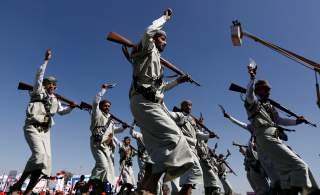3 Ways to Change Yemen
The violence in Yemen will continue to wreck the lives of the country's impoverished citizens until a stable government steps in and takes control of the situation.
The U.S. Senate voted on December 13 to move forward with a measure to cut military aid supporting Saudi Arabia in its ongoing involvement in the conflict in Yemen. This is the latest development in a continuing discussion on the bleak situation in the region’s most impoverished nation and what the American role must be in alleviating human suffering. How should the United States balance the pursuit of a Yemeni peace while countering hostile forces in the Middle East?
A December 12 discussion at the Center for the National Interest sought to shed light on these questions. The discussion was moderated by Geoffrey Kemp, senior director for Regional Strategic Programs at CFTNI. Panel members included Daniel Byman, senior fellow at the Brookings Institution’s Center for Middle East Policy, and Gerald Feierstein, senior vice president at the Middle East Institute and former U.S. Ambassador to Yemen under President Barack Obama. Byman began his introduction by noting that one important caveat on the statistics surrounding the conflict in Yemen is that there are “incredible problems” with the data collected. “Very basic questions, such as roughly how many people have died in the war, are not known within any certain margin of error,” he said. Byman explained that it is virtually impossible to answer a question about how long the war has lasted. Did it start five years ago or fifteen years ago? Nobody can agree on the time frame. Feierstein also noted that five to fifteen years ago is still too optimistic of an outlook. The conflict in Yemen truly dates back to sixty years ago and stems from its inability to forge a coherent political system after independence from the British in 1967, he said.
And who exactly are the key players in the ongoing Yemeni civil war? Within Yemen, one of the principal factions is the government regime, which remains internationally recognized, despite its lack of legitimacy among Yemenis. The Houthis remain the most dominant faction. Still, other units including the Muslim Brotherhood and Al Qaeda stake claims across the country and the Arabian Peninsula. Among these, notes Byman, “you have a lot of jostling over patronage, a lot of jostling over territory and basic control issues.” Outside of Yemen, Saudi Arabia intervened in 2015 in response to fears over an ascending Iran, which had been working in a limited capacity to support Houthi forces. Saudi involvement in Yemen continues with the blessing of Crown Prince Mohammed Bin Salman, who has embraced the conflict to the point that his credibility as a leader is tied to it. “If Saudi Arabia is to withdraw, it’s a political blow to the Crown Prince. His prestige is vested in this war,” Byman said. When it comes to the Saudi role in Yemen, Gerald Feierstein emphasized that the Western world seems to have an “obsession with looking at Yemen through the context of Saudi Arabia” and with conflating Yemen with the case of Jamal Khashoggi’s killing. That is a grave mistake, he said. Sharing fears over Tehran’s partnership with Houthi forces, the United States has sought to counter Iranian influence by offering munitions and Air Force support to Riyadh.
Emirati forces, however, have demonstrated a much higher capacity for warfare than the Saudis and have taken the lead on pushing back against Al Qaeda without much support from the United States. The UAE ultimately wants a friendly government in Sana’a as well as a secure southern border and safety from Hezbollah or IRGC fighters.
But there have been some recent positive developments for Yemen. UN-led peace talks in Stockholm concluded Thursday and yielded some margin of progress. Feierstein noted that Special Envoy of the Secretary General for Yemen Martin Griffiths has kept expectations low so as not to derail the goals of the dialogues. In addition to maintaining realistic expectations, there are three key goals that must be addressed. The first goal to reach is a ceasefire because nothing else can be accomplished without a halt in hostilities, Feierstein said. The second goal should be to ensure that public and private aid organizations make available crucial supplies to combat the worsening humanitarian crisis. The military activity at the Port of Hudaydah has severely limited supplies to a desperate population. It is important to note, however, that even if the port is opened for supplies, a lack of buying power and economic stability prevents Yemenis from purchasing what they need to survive. The third goal of the talks then must be to work towards re-establishing the economy by stabilizing currency rates and building the central bank back up.
Despite disagreements over subjects like the competence of past Al Qaeda leadership in Yemen, both panelists agreed that the violence in Yemen will continue without a stable government to take control of the situation—even if Saudi Arabia (with U.S. support) and the United Arab Emirates were to pull out of the country. Dozens of warring factions combined with a decimated infrastructure and wrecked economy have left Yemen in a seemingly hopeless situation. Additionally, an absence of Saudi and Emirati forces would ultimately lead to an Iranian victory. According to Feierstein, Yemen is neither a proxy war nor a sectarian war but rather “a classic failed state.” Until further talks can reconvene and rebuild a stable government, economy, and infrastructure, the war in Yemen will continue to yield a growing humanitarian crisis.
Caroline Caywood is a program assistant with the Center for the National Interest and a recent graduate of Baylor University.
Image: Reuters

